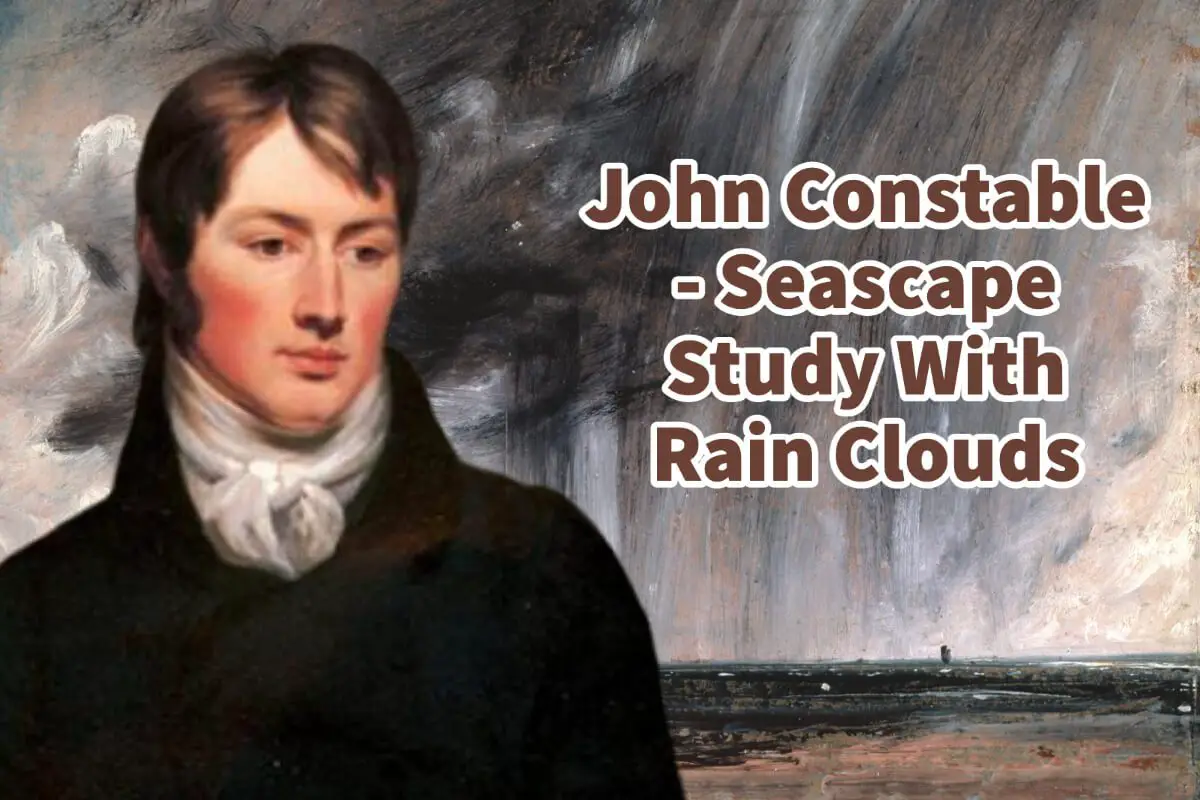When you think about a painting that understands nature and the clouds, I think of the British painter John Constable. John Constable was a master at studying the weather, clouds, and the sky.
John Constable studied nature and clouds and would paint the same scene repeatedly but with different kinds of weather. One of his better-known and more interesting paintings is Rainstorm Over The Sea; this painting shows fierce clouds over the skies of Brighton, England.
Table of Contents
- John Constable’s Study Of Nature And Clouds
- John Constable’s Rainstorm Over The Sea Or Seascape Study With Raincloud
- 10 Reasons to Admire John Constable: Celebrating His Artistry
- Frequently Asked Questions
- Related Questions
John Constable’s Study Of Nature And Clouds

John Constable (1776 – 1837) was an English artist fascinated with the skies and nature. He spent countless hours studying the sky and nature.
This led him to make similar studies from nature, usually showing the exact location transformed by different light and weather patterns.

With his studies of nature and the skies, John Constable would work fast on his paintings. He would make hasty sweeps with his brush. John Constable’s Rainstorm Over The Sea is an excellent example of how he would work quickly to show the forces of nature, the cloud, and the sky.
John Constable And The Study Of Weather
One of the fascinating things about John Constable was his study of nature and how different weather patterns would change nature. He painted many of the same scenes again and again but with different types and kinds of weather.

John Constable did not just paint the weather but also studied the weather and weather patterns. John Constable was not just an artist but also a scientist.
Many of his smaller sketches were not intended to be shown to the public but were used as references for some of his more significant works of art. But many of these smaller and quicker drawings are today considered significant works of art.
One of those is his miniature painting, Rainstorm Over The Sea, which was painted sometime in the 1820s.
John Constable’s Rainstorm Over The Sea Or Seascape Study With Raincloud

One of John Constable’s better-known paintings is his Rainstorm Over The Sea. This artwork that he produced in the 1820s England is very different from what other artists during his day were producing.
We are not sure exactly when the painting was painted, but we know it was between 1824 to 1828. The painting has two names: the Rainstorms over the Sea and the Seascape Study with Raincloud.
The Rainstorm Over The Sea is one of the Constable’s most dramatic scenes that he painted while he was living in Brighton. The thunderous clouds and the downpour shows how violent nature can be.
In many of his previous paintings, Constable would paint one person or boat, but this painting is almost void of all, and the concentration is on the storm and the sky.
In this sketch, Constable is also looking directly out to Sea. The perspective of the painting makes them unique painting.

Listen To Our Podcast About John Constable – The British Painter by clicking here.
John Constable’s Rainstorm Over The Sea – Moody Blues
In his Rainstorm Over The Sea, John Constable shows dark and brooding clouds with a kind of abstract expressionist kind of feel. What makes this painting so unique is painting is so different from the images others were painting of the cozy English countryside.
The setting of this painting is Brighton on a stormy day. The painting shows signs of abstraction art.
John Constable’s Rainstorm Over The Sea – Black Clouds
John Constable uses a lot of dark colors to portray the clouds in the sky. This painting shows the power of a cloud coming over the Sea.
It is a powerful painting that shows the power of the storm and how a painting can set the movement of clouds in time.
John Constable’s Rainstorm Over The Sea – Study Of Clouds
When John Constable painted this, he actively studied the clouds and the sky. He was caught up in the passion of learning about the sky and clouds.
Over the following years, he continued to conduct many studies about clouds and clouds and the sky.
The exciting part of this painting is that most of the painting is the sky. Very little is water or even land, but it is almost all sky.
John Constable’s Rainstorm Over The Sea – Quick Painting
John Constable painted this painting very quickly. When he painted this, painters were not doing en Plein airs as the paints could not be transported very easily.
It was said that he pinned the paper to his paint box when he painted this painting. He worked very fast as he worked with the paper and his paints. This painting is on paper and then laid on canvas.
Because this was painted outside on a piece of paper, the painting is not very large; the painting is 9 1/4” x 12 3/10” size or 23.5 cm x 32.6 cm.
10 Reasons to Admire John Constable: Celebrating His Artistry
We love and admire the artist John Constable. Here are our 10 top reasons.
- Masterful Cloud Studies: John Constable’s cloud studies are unparalleled. His detailed observations of the sky demonstrate his deep appreciation for the natural world, making him a pioneer in capturing the ephemeral beauty of the heavens.
- Distinctive Style: Constable’s style, characterized by its fluidity and vibrancy, sets him apart. His ability to imbue landscapes with life and movement reflects his unique artistic voice.
- Innovative Use of Color: His innovative use of color, especially in depicting natural light, adds a realistic and dynamic quality to his paintings, showcasing his exceptional understanding of color theory.
- Detailed Landscapes: Constable’s landscapes are renowned for their meticulous detail, capturing the essence of the English countryside with authenticity and precision.
- Emotional Depth: Beyond mere representation, his works often evoke a sense of nostalgia and tranquility, inviting viewers into a deeper emotional experience.
- Contribution to Romanticism: As a major figure in the Romantic movement, Constable’s work emphasizes emotion and a reverence for nature, influencing generations of artists.
- Technique and Texture: His innovative brushwork and use of impasto create a rich texture in his paintings, making them not only visually striking but also tactilely engaging.
- Depictions of Rural Life: His commitment to portraying the rural landscapes and the daily life of his surroundings offered a valuable glimpse into 19th-century England.
- Inspiration to Future Artists: Constable’s work significantly influenced the Barbizon School and the Impressionists, making him a key figure in the transition to modern art.
- Enduring Legacy: The enduring appeal of his work, which continues to be celebrated and studied, highlights his lasting impact on the art world and his status as a beloved figure in art history.
Anita Louise Art is dedicated to art education, great artists, and inspiring others to find and create their art. We love art that uplifts and inspires. #ArtToMakeYouSmile! #ArtToMakeYouHappy!
If you are interested to see any of my art, you can find out more by clicking here. If you are interested in what inspires me and my paintings, you can discover more by clicking here.
We have a free newsletter and would love you to be part of our community; you can subscribe to the newsletter by clicking here. If you have any questions, I would be happy to talk to you anytime. You can reach me, Anita, by clicking here.
Subscribe to our Anita Louise Art YouTube Channel with great videos and information by clicking here.
Join us for our podcast “5 Minutes With Art.” Spend just 5 minutes a week with us to discover and learn about great art and artists. You can find out more about our podcast by clicking here.
Frequently Asked Questions
What is “Seascape Study with Rain Clouds” by John Constable?
“Seascape Study with Rain Clouds” is a renowned painting by John Constable, depicting a seascape with a particular focus on the atmospheric conditions, especially rain clouds. It is an excellent example of Constable’s mastery in capturing the nuances of weather and nature.
How did John Constable approach the study of nature and clouds in his paintings?
Constable was known for his meticulous study of nature and clouds. He often painted the same scene multiple times, exploring the variations in weather conditions. His dedication to capturing the essence of the changing skies is evident in works like “Seascape Study with Rain Clouds.”
Can you describe the scene depicted in “Seascape Study with Rain Clouds”?
The painting portrays a seascape with a focus on rain clouds. The scene likely captures a moment of atmospheric drama, with the artist’s keen attention to the details of the clouds and the overall mood of the sky over the sea.
Why is John Constable considered a master at studying weather and clouds?
Constable’s mastery lies in his ability to observe and depict the subtleties of weather patterns and cloud formations. His dedication to repeatedly painting the same scenes under different weather conditions showcases his commitment to understanding and portraying nature faithfully.
How does “Seascape Study with Rain Clouds” differ from other works by John Constable?
While Constable painted various landscapes and seascapes, “Seascape Study with Rain Clouds” stands out for its emphasis on the dramatic presence of rain clouds. It provides a unique perspective on the interplay between the sea and the ever-changing sky.
What techniques did John Constable employ to capture the essence of rain clouds in his paintings?
Constable’s techniques included careful observation, use of color and light, and a deep understanding of meteorological conditions. His brushstrokes and choice of colors in “Seascape Study with Rain Clouds” likely contribute to the vivid representation of the stormy atmosphere.
Where was the inspiration for “Seascape Study with Rain Clouds” drawn from?
Constable drew inspiration from his surroundings, and it’s likely that the scene depicted in the painting was influenced by the coastal landscapes he encountered, possibly around Brighton, England. The choice of location often played a significant role in shaping his artistic vision.
How did John Constable’s fascination with nature influence his artistic philosophy?
Constable’s deep appreciation for nature greatly influenced his artistic philosophy. He believed in painting directly from nature, and his dedication to capturing the ever-changing aspects of the natural world set him apart as a prominent figure in the Romantic movement.
What emotions or moods does “Seascape Study with Rain Clouds” evoke?
The painting likely evokes a sense of drama and intensity due to the presence of rain clouds. Constable’s skillful depiction of the stormy atmosphere may elicit feelings of awe, contemplation, or even a sense of the sublime as viewers engage with the dynamic interaction of sea and sky.
How has “Seascape Study with Rain Clouds” contributed to John Constable’s legacy?
he painting adds to Constable’s legacy by exemplifying his mastery in capturing the transient beauty of nature. “Seascape Study with Rain Clouds” serves as a testament to his commitment to studying and portraying the atmospheric conditions, leaving an indelible mark on the art world and inspiring future generations of landscape painters.
Related Questions
All About En Plein Air Painting, What You Need to Know
En Plein air means “in the open air.” It refers to a style of painting outside in natural light. This term was made famous by the French Impressionist art movement. Many of the French Impressionists painted most of their paintings outdoors. Many equipment and other challenges were associated with painting everything outdoors.
By clicking here, you can discover more by reading All About En Plein Air Painting, What You Need to Know.
John Albert Bauer, Sweden’s Gnomes and Troll Artist (1882-1918)
John Albert Bauer is the Swedish artist and illustrator most widely known for his gnomes and trolls. Because of his detail in studying the Sami people in Northern Sweden, he used many of these same artifacts in his illustrations. He is most well known for his illustrations in the anthology called Among Gnomes and Trolls.
By clicking here, you can learn more by reading John Albert Bauer, Sweden’s Gnomes and Troll Artist (1882-1918).
What Was The Impact Of Vincent Van Gogh On The Art World?
Van Gogh used color, form, and emotions in his art. He had a bright palette that was individualized for his time. Even though he did not see a lot of success during his life after he died, the impact of his art can be seen in both the Expressionism and Fauvism movements that were taking place in Europe.
By clicking here, you can learn more by reading What Was The Impact Of Vincent Van Gogh On The Art World?


